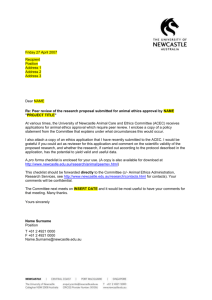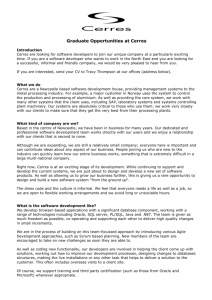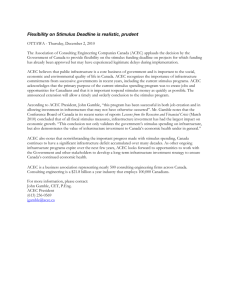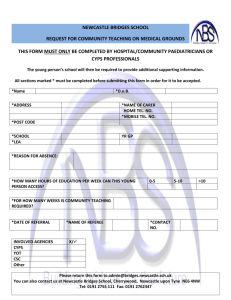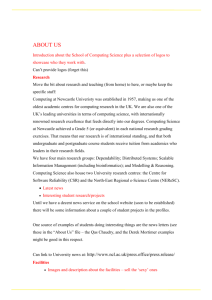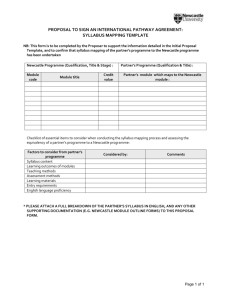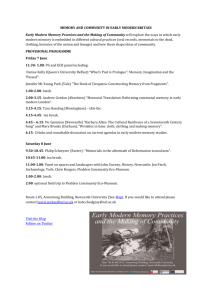Examples - University of Newcastle
advertisement
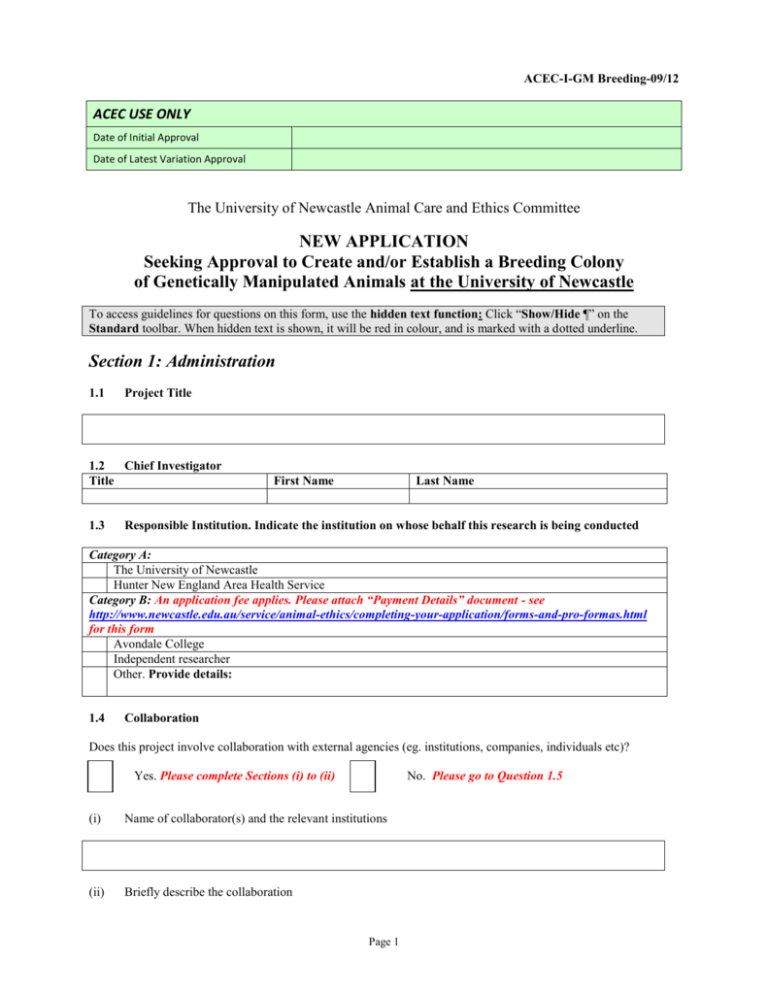
ACEC-I-GM Breeding-09/12 ACEC USE ONLY Date of Initial Approval Date of Latest Variation Approval The University of Newcastle Animal Care and Ethics Committee NEW APPLICATION Seeking Approval to Create and/or Establish a Breeding Colony of Genetically Manipulated Animals at the University of Newcastle To access guidelines for questions on this form, use the hidden text function: Click “Show/Hide ¶” on the Standard toolbar. When hidden text is shown, it will be red in colour, and is marked with a dotted underline. Section 1: Administration 1.1 Project Title 1.2 Chief Investigator Title 1.3 First Name Last Name Responsible Institution. Indicate the institution on whose behalf this research is being conducted Category A: The University of Newcastle Hunter New England Area Health Service Category B: An application fee applies. Please attach “Payment Details” document - see http://www.newcastle.edu.au/service/animal-ethics/completing-your-application/forms-and-pro-formas.html for this form Avondale College Independent researcher Other. Provide details: 1.4 Collaboration Does this project involve collaboration with external agencies (eg. institutions, companies, individuals etc)? Yes. Please complete Sections (i) to (ii) No. Please go to Question 1.5 (i) Name of collaborator(s) and the relevant institutions (ii) Briefly describe the collaboration Page 1 (iii) Has this project been approved by your collaborator’s Animal Ethics Committee? No Yes If yes, please attach a copy of any application submitted to, and notification of approval from, your collaborator’s Animal Ethics Committee. See: http://www.newcastle.edu.au/service/animal-ethics/managingprojects/collaborative-research.html 1.5 Application Type Please indicate which one of the following types of application is appropriate for this submission A new project A significantly revised current project An application that was previously submitted and not approved. An application related to an existing project with current ACEC approval Provide the relevant ACEC approval numbers here An application that represents a combination of two or more projects with CURRENT approval. Provide the relevant ACEC approval numbers here Please note that a final report will be required for each project. Substantially the same project as submitted to a collaborator’s Animal Care and Ethics Committee as described in 1.4 1.6 Prior Consideration Has approval been sought for this project, or substantially the same project, from the Animal Care and Ethics Committee or another Animal Ethics Committee? No 1.7 Yes. If yes, provide reasons for the re-submission or simultaneous submission, the name of the ACEC(s) and the outcome of the application(s). Cancellation of Authority or Licence Has any Animal Research Authority or Animal Supplier's Licence held by the Chief Investigator or any other Page 2 investigator named in this application been cancelled? No 1.8 Yes. If yes, provide details below. These details should include the researcher’s name, the institution where the cancellation occurred, the year that the cancellation occurred and the circumstances of the cancellation. Is a research student’s project dependent upon this approval? No Yes If yes, provide details below and duplicate the information for each student. Program should include undergraduate, honours, MSc, PhD etc (e.g. Summer Scholar, undergraduate project) Student’s Name: Program: 1.9 Project dates Please indicate the expected timeframe for the project Proposed commencement date: Month: Year: Expected completion date: Month: Year: Please note that ACEC project approval is for a period of one year and subject to annual review. Is there a research related reason why it is desirable to commence this project by a specific date? No 1.10 Yes If yes, provide details below. This may relate to a visiting researcher, access to particular animals, etc. Statutory Reporting - Purpose of the project. Indicate the most appropriate description of the primary purpose of the project for which the animals bred in this project will be used(For explanation of the “Purpose Description”, click “Show/Hide ¶” on the Standard toolbar.) 1. 2. 3. 4. 5. 6. 7. 8. 9. 10. Non GM Stock breeding Stock maintenance Education Research: human or animal biology Research: human or animal health and welfare Research: animal management or production Environmental study Production of biological products Diagnostic procedures Regulatory product testing 1.11 Health and/or safety risks (i) Indicate which of the following health and/or safety risks to other animals, people or the community are Page 3 involved with this project, in addition to the use of GM animals. Anaesthetic gases Carcinogens Teratogens Chemically hazardous material or cytotoxic substances (not including anaesthetic gases) √ GMOs – animals GMOs other than animals Biologically hazardous materials (microorganisms, human tissue, fluids etc) Radiation hazard Potential zoonosis Other - Provide BRIEF details here: Not Applicable (ii) Does this project involve persons associated with the University of Newcastle, or animals housed in the University of Newcastle Animal Services Unit facilities? No (iii) Yes. If yes, safety approval from the relevant University of Newcastle OH&S subcommittee is required. Refer to http://www.newcastle.edu.au/service/committees/ohs/ Approval from University of Newcastle Institutional Biosafety Committee to breed Genetically Modified Animals. Biosafety approval was received on (insert date): Biosafety approval has been requested but not received. Biosafety approval is not required; please explain below. Section 2: Justification for Animal Breeding 2.1 Related applications/projects. Breeding applications are only accepted by the ACEC if animals are to be produced for a research project/s that has already been approved by the ACEC or which has been submitted for approval to the ACEC. (i) Provide a brief summary of the research project with which this application is associated (ii) Does this research project have current ACEC approval? Yes. Please provide current ACEC Approval Number: No. Page 4 2.2 Could the animals that will be bred be purchased from commercial sources in the required numbers? No. Yes. Please describe the rationale for breeding these animals at the University of Newcastle below. Rationale: Page 5 Section 3: Breeding Colony Details and Management 3.1 Species and Numbers List species and strain to be bred and indicate the number of breeders required. Provide estimates for the numbers of offspring expected and their disposition. SPECIES STRAIN ID / NICKNAME (IF APPLICABL E) BACKGROU ND STRAIN GENE(S) SYMBOL(S) TYPE (EG. TG, KO) NO. OF BREEDERS MALE FEMAL E EXPECTE D NO. OF OFFSPRI NG ESTIMATED NO. OF OFFSPRING TO BE USED FOR NEW BREEDERS ESTIMATED NO. OF OFFSPRING TO BE TRANSFERRED TO RESEARCH PROTOCOL ESTIMATED NO. OF OFFSPRING TO BE EUTHANASED WITHOUT USE* * Section 3.3.62 of the Code of practice for the care and use of animals for scientific purposes requires that records of the number of animals bred to support the project must be maintained and that the fate of those animals that do not have the required phenotype be considered. Page 6 3.2 A. Breeding Plan The breeding method will be: Monogamous (single male & female in a cage) Harem (single male & multiple females). Please indicate which of the following will apply: Males will be removed once females are confirmed pregnant. Females will not be re-bred until offspring are weaned. Individual pregnant females will be moved to new cages prior to delivery of offspring. Females and their litters will be moved to larger cages to provide required floor space. B. Special Care (feed/water/temperature/humidity/air flow) instructions for this breeding colony No special care is required. Special care is necessary to keep these animals healthy; please describe. Description: C. Normally weaning of rodents occurs at 21 days. Will this occur in this project? Yes. No, please justify the need for deviating from this weaning period, including specifying the age at which weaning will occur. Description: 3.3 Disposition of breeders and unneeded offspring A. Retired breeders Euthanasia according to protocol (as per Question 3.11). Used in experiments; please explain below. Other; please explain below. Explanation: B. Offspring not required for future breeding Transfer to ACEC Approval Held by Chief Number Investigator (Name) Transfer to collaborator. Please explain below. Euthanasia according to the protocol (as per Question 3.11). Please explain below why these animals cannot be used for a protocol. Explanation: 3.4 Method of tissue collection for genotyping. Genotyping is not necessary for this project. Ear punch tissue will be collected for genotyping in accordance with ACEC approved SOP#31- Earpunching. Other method of tissue collection for genotyping- please describe fully below and justify the need if the method of tissue collection is more invasive than earpunching (e.g. tail cutting). Details: Animals: Source, Housing and Management Reference: http://www.newcastle.edu.au/research/asu/ Page 7 3.5 From where will the original breeding animals be obtained? (check one) Animal Services Unit, University of Newcastle. Directly from an external supplier, researcher or institution (e.g. another University) Provide details below. Animal reused from another project. Complete attachment N Privately owned. Importation from outside Australia. Identify the source. Genetic engineering will occur at the University of Newcastle. Provide details of genetic engineering below. 3.6 Is a permit required to obtain, hold or use the animals (eg. Australian Quarantine Information Service [AQIS], Office of the Gene Technology Regulator [OGTR], NSW National Parks and Wildlife Service [NPWS])? If YES, provide details. 3.7 Where will the animals be housed (tick all facilities which are applicable)? Central Animal House Amphibian Facility: Nursing Building Courtyard Medical Sciences Building Animal Facility: Level 2 Amphibian Holding Room (Room BLG06) Medical Sciences Building Animal Facility: Level 3 Amphibian Facility: Amphibian Controlled Environment Room (ACER) Hunter Medical Research Institute Amphibian Facility: Frog Ponds (north west of Forum) Research Support Unit, John Hunter Hospital Wallaby Yards - Central Animal House Behavioural Sciences Animal Facility Small Marsupial Facility - Central Animal House Wallaby Breeding & Holding Yards (Aviation Road) Hunter Wetlands Centre Ash Island Brickpit, Sydney Olympic Park, Homebush Skywood Equestrian Centre Details of other housing. If the facility or location is not listed contact the Animal Ethics Officer in the Research Integrity Unit on 16377 to arrange an inspection of the site and an application to NSW Industry and Investment. 3.8 Holding of Animals Animal Services Unit (ASU) Facilities Page 8 Have you consulted the Manager, Animal Services Unit regarding the housing of your animals? 3.9 Yes If yes, what facilities to hold your animals are available? No If no, who have you consulted and are appropriate facilities available for the holding of your animals? What level of physical containment is required for the housing/handling of the animals? Specific Pathogen Free (SPF) PC1 PC2 Other. Please specify below. 3.10 Describe the housing and husbandry requirements. Duplicate this table if there are different requirements for particular groups of animals. Standard Animal Services Unit (ASU) housing If not standard ASU housing please provide the following information: Species/Strain Caging or housing Maximum and minimum number of animals per cage/pen Environmental enrichment: Diet: Water: Special care: 3.11 Once allocated to the project, will live animals be transported from the animal facility/location where they are housed? Yes. Provide details below. No. How will they be transported? The location where they will be taken? How long will they be held outside of the facility? Will live animals be returned to the facility? NOTE: Approval of this request is limited to a review of ethics and animal welfare, and does not guarantee accommodation. All shipping and housing arrangements must be made with the Animal Services Unit Associate Director or designate. Page 9 3.12 Project Procedure Classifications This information is required for inclusion in the University’s annual return to NSW Industry and Investment (For definitions of these classifications, click “Show/Hide ¶” on the Standard toolbar.) (i) Procedure Indicate the category (or categories) that best describes all procedures carried out on the animals in the project. More than one category may apply to this project. Please indicate all that apply. 1. 2. 3. 4. 5. 6. 7. 8. 9. Observation involving minor interference Animal unconscious without recovery Minor conscious intervention Minor surgery with recovery Major surgery with recovery Minor physiological challenge Major physiological challenge Death as an endpoint (where the death of an animal is a planned part of the procedures and animals die but are not euthanased) Production of genetically modified animals 3.13 Specific Procedures (i) Indicate whether the project involves any of the following procedures/situations. The appropriate attachment must be appended to your application. If using ACEC approved Standard Operating Procedures (SOP)s, list these in question 3.13 (ii) below. Indicate all of the following procedures that will be used in the project Indicate if Attachment or SOP is used: Attachment SOP C D E F NA H NA K NA N (ii) Procedure Non-survival surgery Survival surgery Use of anaesthesia not associated with surgery (survival or non-survival) Blood collection (other than terminal collection) Administration of substances Transport of live animals at any time during the project Re-use of animals that have been the subject of a previous scientific or teaching activity Please provide a list of ACEC Approved Standard Operating Procedures that will be used in this project. Information concerning ACEC Approved Standard Operating Procedures is available at the SOP web site http://www.newcastle.edu.au/service/animal-ethics/managing-projects/standard-operatingprocedures/index.html If an SOP was last approved by the ACEC more than 3 years ago, please review, modify as needed and attach the SOP to this application, leaving the header containing the previous approval date intact. If an SOP is to be modified, please attach a track-changed copy of the procedure. SOP TITLE SOP APPROVAL NUMBER Page 10 DATE SOP APPROVED (iii) New SOPs Please list any new SOPs for which you are seeking approval in this project in the table below and attach a copy to this application. Title of New SOP Purpose Are you willing for this SOP to be made available to other research groups on the ACEC website? Yes/No Euthanasia 3.14 If animals will be euthanased please complete parts (i) and (ii) below: (i) Detail the method of euthanasia to be used. Reference: http://www.newcastle.edu.au/service/animal-ethics/managingprojects/specific-techniques.html Species (ii) Method Drug name (generic Dose rate (mg/kg name, not trade name) body weight) Route Where will euthanasia normally be performed? It is the expectation of the ACEC that animals will be euthanased in a quiet, clean environment away from other animals. (iii) What method of disposal will be used for dead animals? Refinement 3.15 Animal Welfare Impact Identify all aspects of this project that may adversely impact on the wellbeing of the animals using the table below. Anticipate and describe any potential adverse effects on the animals, and the steps you will take to avoid, minimise or manage these effects. Justification. Provide justification for the impact of procedures on animals in this project taking into account the ethical considerations, the impact on the welfare of the animals and the anticipated scientific or educational value. Note: The legislation requires provision of particular justification for specific situations (see guidelines). Factor Potential adverse effects on the Justify the adverse event risk and Page 11 (Delete or add rows as needed) The factors listed below are a guide only. Ensure that you include all other factors that may adversely impact animals in this project. Anaesthesia with recovery Anaesthesia without recovery Behaviour testing Blood / body fluid collection Chronic instrumentation (eg. electrodes, catheters, transmitters etc) Diet / water modification Effect of genetic modification Euthanasia Experimental housing or environment Experimental restraint Handling Induction of tumours Infection with microbial agents, parasites etc Other treatments Substances administered Must be outlined in Attachment H Surgical procedure(s) Techniques used to administer substances (eg. Injection, gavage, intra-tracheal) Transport Other (add rows as necessary) animals indicate how potential adverse effects on the animals will be minimised. If referencing an SOP in this section, please include the reference number. Section 4: Phenotype Report 4.1 Is a phenotype report attached to this application? (available at http://www.newcastle.edu.au/research/animal/forms-animalethics.html) Yes. Please go to SECTION 5. No. 4.2 How much is known about the biological characteristics/phenotype of this strain? Well characterised Partially-characterised/some information available Unknown 4.3 When was this genetically modified animal created, or mutant animal discovered? 4.4 How many generations of this genetic modification or mutant animal have been produced? 4.5 Is the genetic modification/mutation stable? If NO, provide details. Page 12 4.6 Briefly describe the function of the gene(s) that have/will be modified or have mutated. 4.7 What organs/tissues are affected (eg. gene expressed in liver only). 4.8 What abnormalities are known to exist, or do you expect, in these animals (eg. behaviour, physiology, reproductive or developmental measures). Your answer to this question should inform the ACEC about abnormalities or changes which have a welfare impact. (See hidden text guidelines) 4.9 Detail any problems with the breeding of these animals 4.10 Detail any problems associated with the housing or use of these animals. 4.11 Provide details of any special husbandry or specialist care to be provided to the animals to minimise the impact of any adverse effect from the genetic modification/ mutation. Section 5: Monitoring 5.1 Who will monitor the animals? Note: Details of these personnel and their experience with animal welfare monitoring must be included in Section 6. (i) On weekdays including outside regular working hours? (ii) On weekends and public holidays? 5.2 Have you attached a specific monitoring checklist, with appropriate endpoints, for monitoring the effect of the genetic modification/ mutation on the welfare of these animals? If NO, why not? Note: Detailed monitoring protocols for the detection of expected and unexpected adverse effects in these animals must be provided. Humane endpoints Page 13 5.3 Provide details of the clinical, behavioural or other signs that will be used to indicate that an intervention is necessary and the actions will you take if these signs are observed (eg. increase in the frequency of observations, consultation with a veterinarian, administration of analgesics or other appropriate medication, euthanased Emergencies 5.4 The Chief Investigator for this project is ultimately responsible for the welfare of animals used. In the absence of the Chief Investigator, who will be responsible for the management of emergencies and what are their emergency contact details? 5.5 What is the anticipated morbidity or mortality rate and why? Indicate if this will vary in different parts of the project. 5.6 If an animal dies or is euthanased due to complications, who will perform the post mortem? Note: An adverse event report must be submitted to the ACEC should this occur. Section 6: Details of Personnel Involved with the Project 6.1 Chief Investigator Name: Title/first name/family name Qualifications: Organisational unit: Mailing address: Telephone B/H: Telephone A/H: Telephone Mobile: Email: Number Plate e.g. ABC123 Attendance at RATS training program (Research Animal Training Scheme)? Yes/No If yes, please indicate modules completed and date of attendance. Will this researcher be monitoring the animals? No Yes. If yes, please outline this researcher’s experience in relation to the monitoring of the species to be used in this project Experience with techniques to be performed on live animals, and species to be used, by this person IN THIS PROJECT: Technique or Procedure Species Level of RECENT experience Page 14 (Approx. number of times this person has performed the procedure in this species in the previous 5 years) None (eg. <5) Limited (eg. 5-20) High (eg. >20) If inexperienced with either the species or procedure(s), how will experienced be gained and who will provide technical guidance to other personnel on this project? Details for person providing technical advice must be provided under Question 4.3, even if the person is an external expert. 6.2 Alternate Chief Investigator Note: This person will assume the responsibilities of the Chief Investigator during any absence of the Chief Investigator, and must be associated with the institution nominated in Q1.3 Name: Title/first name/family name Qualifications: Organisational unit: Mailing address: Telephone B/H: Telephone A/H: Telephone Mobile: Email: Number Plate e.g. ABC123 Attendance at RATS training program (Research Animal Training Scheme)? Yes/No If yes, please indicate modules completed and date of attendance. Place ‘x’ in the box if this is the first time this person has been named on a University of Newcastle animal ethics application. Will this researcher be monitoring the animals? No Yes. If yes, please outline this researcher’s experience in relation to the monitoring of the species to be used in this project. Experience with techniques to be performed on live animals, and species to be used, by this person IN THIS PROJECT: Technique or Procedure Species Level of RECENT experience (Approx. number of times this person has performed the procedure in this species in the previous 5 years) None (eg. <5) Page 15 Limited (eg. 520) High (eg. >20) If inexperienced with either the species or procedure(s), how will experienced be gained and who will provide technical guidance to other personnel on this project? Details for person providing technical advice must be provided under Question 4.3, even if the person is an external expert. 6.3 Other people participating with the use of animals in this project Name: Title/first name/family name Qualifications: Role in project: If student: Program: Insert as necessary; eg. Co-investigator, Research Assistant, Technician, Collaborative Researcher, Student, External Researcher, Volunteer etc Undergraduate / Honours student/ Masters student/ PhD student/ Other (please specify) (delete as necessary) Student Number: Organisational unit/Mailing address: Telephone B/H: Email: Number Plate e.g. ABC123 Attendance at RATS training program (Research Animal Training Scheme)? Yes/No If yes, please indicate modules completed and date of attendance. Place ‘x’ in the box if this is the first time this person has been named on a University of Newcastle animal ethics application. Will this researcher be monitoring the animals? No Yes. If yes, please outline this researcher’s experience in relation to the monitoring of the species to be used in this project. Experience with techniques to be performed on live animals, and species to be used, by this person IN THIS PROJECT: Technique or Procedure Species Level of RECENT experience Supervisor's name (Approx. number of times this person has performed (if "None" or the procedure in this species in the recent past) "Limited") None Limited High (eg. <5) (eg. 5-20) (eg. >20) For each additional person, copy the table above and complete. Section 7: Investigator Declaration of Responsibilities I confirm that I and members of the research team have read the NSW Animal Research Act and Regulations, and the Australian Code of Practice for the Care and Use of Animals for Scientific Purposes, and accept responsibility for compliance with all aspects of the legislation and the Code relating to the project. I declare that I have the appropriate qualifications and experience to perform the procedures described in this application or to ensure that they are done correctly. I accept responsibility for ensuring that each person involved with this project has the necessary experience to Page 16 perform the procedures they are to carry out. If they are not already skilled in the procedures, I accept responsibility for ensuring that they obtain the necessary training in advance, and appropriate supervision, so that each procedure on an animal will be carried out in the most appropriate manner. I confirm that all other persons involved with this project have received or have access to a copy of this application, and will receive a copy of any associated correspondence or documentation from the ACEC. I confirm that all other persons involved with this project have read this application and have agreed to conduct the project as outlined in this application in accordance with the legislation, and the requirements of the University of Newcastle ACEC. I confirm that adequate resources are available for the conduct of this project. Name Signature Date Chief Investigator: Please note that should this application be forwarded by the Chief Investigator via email, a signature is not required. Please ensure that you have responded to every question (even if your response is “not applicable”). Section 8: Application Fee For applications submitted by researchers who are NOT from the University of Newcastle or the Hunter-New England Area Health Service: A fee of $500.00 must be paid before the application will be processed. The fee is for a 12 month period of licence, unless sooner cancelled or suspended. Please attach Payment details (see http://www.newcastle.edu.au/research/research-services/animalethics/completing-your-application/forms-and-pro-formas.html ) You have reached the end of this part of the application form. Please ensure that you have responded to every question (even if your response is "Not applicable"). If you have been requested to do so, you must now attach relevant documents to this application. Page 17
